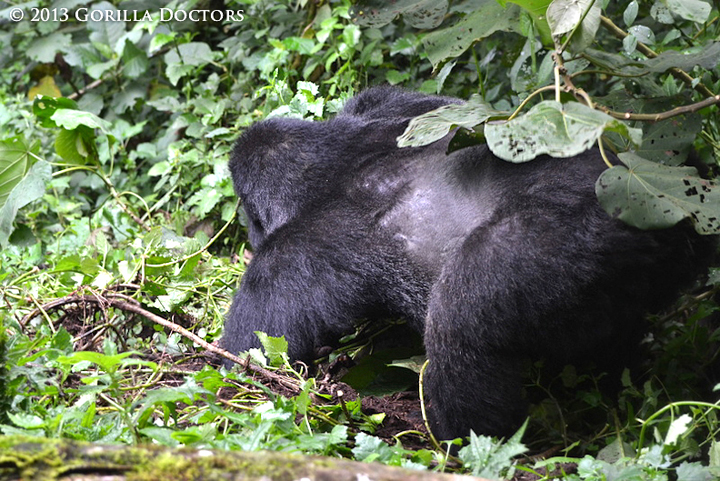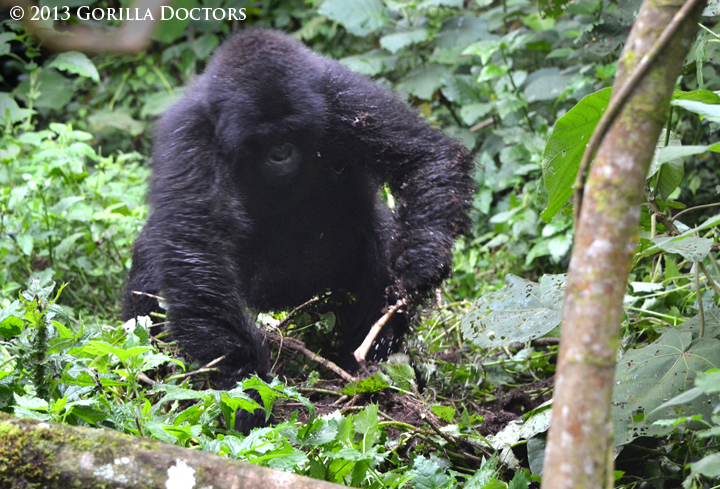Dr. Jean Felix’s Tool Use Observation Published in American Journal of Primatology
By Gorilla Doctors Staff on Monday, December 8th, 2014 in Blog.During a routine health check of Kwitonda group in May 2013, Dr. Jean Felix had the incredible opportunity to witness the first documented incidence of tool use for food acquisition by mountain gorillas. His observation was recently published in the American Journal of Primatology under the title “Tool Use for Food Acquisition in a Wild Mountain Gorilla (Gorilla beringei beringei)“. The following are excerpts from the article discussing Dr. Jean Felix’s observation and tool use in great apes:
“Kwitonda group consists of 23 idividuals: three silverbacks (≥12-year-old male), one blackback (8-12-year-old male), seven adult females (≥8-year-old female), two subadults (6-8 year-old), three juveniles (3.5-6-year-old), and seven infants (<3.5-year-old). The group has been monitored in Rwanda since 2004, and ranges between Rwebeya stream and Kanyabihunyira hill, primarily in the Neoboutonia Forest and the bamboo zone. A routine health check, including behavioral observations, was performed by one veterinarian and two trackers on May 14, 2013 (the end of the main rainy season) in the Neoboutonia Forest at 7389 feet (2252 m.) altitude.
During the 2 hr monitoring visit, Kigoma, the second ranking silverback, was observed to use his left hand to collect driver ants (Dorylus sp.) from a hole in the ground. When he first inserted his hand into the hole, he quickly withdrew it and ran from the hole while shaking his left arm, presumably to remove the biting ants.”

Kigoma, second ranking silverback of Kwitonda group, searching for ants.

Silverback Kigoma using his left hand to collect driver ants from a hole in the ground.

Driver ants in Volcanoes National Park, Rwanda
“Lisanga, a juvenile female, was approximately 6m away from Kigoma at this time and observed him eating the ants and running away. She then approached the hole and watched the ants entering and exiting the hole for approximately 2 min. She proceeded to insert her left hand into the hole, but quickly withdrew her hand covered in ants, shaking her arm vigorously, again presumably due to painful ant bites. She was then observed to select a piece of wood off the ground that was approximately 20 cm long and 2 cm wide at one end, 1 cm wide at the other. The piece of wood was a freshly broken branch, thought to be from a tree found 2 m from the ant hole. She inserted the stick into the hole and then withdrew the stick, licking the ants off of the stick. After licking the ants off the stick, Lisanga ran away shaking her left hand to remove the still biting ants. No other gorillas appeared to have witnessed Lisanga using the stick nor were any other gorillas observed trying to eat ants during this observation period.”

Juvenile female Lisanga uses a stick to “fish” for driver ants.

Juvenile Lisanga “fishing” for driver ants.

Juvenile Lisanga “fishing” for driver ants.
“Though not related, Lisanga and Kigoma are frequently found together during group observations. They have been observed moving together, grooming each other during the daily resting period, and copulating at a distance from Akarevuro, the leading silverback of the group. Lisanga is known to be a curious individual; for example, one anecdotal report details her showing more than casual interest in a researcher’s bag, quietly approaching behind the researcher and attempting to take the bag away.”
“This is the first time tool use has been reported in a wild mountain gorilla despite the intensive monitoring of this subspecies. The described tool use event is characterized as idiosyncratic and can, in part, be explained by Lisanga’s curious nature as she is known to have an investigative personality. Furthermore, Leca et al. (2010) mentioned that, despite the numerous examples of socially transmitted tool use innovations in several non-human primate species, it should be noted that only a subset of such innovations become tradition and a large part of whether this happens likely depends on cost-benefit considerations. For wild mountain gorillas, ants are not a significant part of their diet perhaps because they do not offer substantial nutritional value per mass ingested, because other food sources are readily available, and/or because they are difficult to obtain without getting bitten. Mountain gorilla diet consists mainly of wild celery, bamboo, thistles, stinging nettles, and some fruit; they are rarely observed to feed on ants – as such, there is not a strong drive for mountain gorillas to use tools to collect ants in a “self maintenance” context… as ants only make up a very minute proportion of their diet, there is lilttle need nor evolutionary advantage for mountain gorillas to seek out the use of tools to obtain them.”
Tool use is well-documented among wild chimpanzees. And captive orangutans, gorillas, chimpanzees and bonobos have all been observed using tools in a variety of contexts for food extraction. However, Dr. Jean Felix’s observation was the first ever report of tool use for food acquisition by a wild gorilla and Gorilla Doctors is proud to have contributed to this important piece of primatological research.


 Donate
Donate